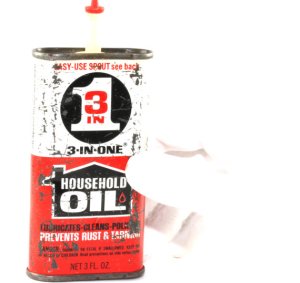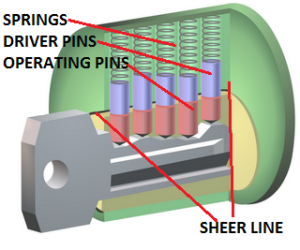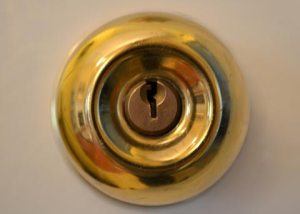Lubrication: A Little Dab’ll Do Ya
A lock will usually last you a life time. Occasionally, with a great deal of use, parts might break. There are a lot of parts inside your lockset. Springs, clips, latches etc. Now, some of the Major Brands are cutting down on manufacturing costs by using less metal in their residential series. Parts that were once solid are now being made with a skeleton like appearance. Something tells me they are not as strong and durable as they used to be. Some are even inserting PLASTIC and NYLON parts where they once were metal. Most of the ‘store brand’ and ‘builder’ hardware manufacturers are NOT doing this however. Also,locks available for sale from your Locksmith are ‘generally’ a little better quality than what is available in the big box hardware stores.
Still, I have seen residential locks lasting 50 years and more. I have some old warded mortise-locks on some of my doors at home. They use a bit-key, what is commonly known as a ‘skeleton-key’. They will be 90 years old next year, and they still operate smoothly.
 So, besides the “Lifetime Finish” meeting an early demise, the most common problem you might encounter, will most likely be a ‘sticky lock’.
So, besides the “Lifetime Finish” meeting an early demise, the most common problem you might encounter, will most likely be a ‘sticky lock’.
When you purchase a new lockset from the hardware store, it comes packed with lithium grease as a lubricant. This will normally last for several years. Direct sunlight, freezing temperatures all serve to break this down and even harden the lithium. 5 or 10 years from purchase may require a fresh application of lithium to the interior of the handles.
You’ll probably want to call a Locksmith for this, since we know where the lithium grease should be applied.
BUT … there are some steps you can take yourself to keep your lock cylinders and latches operating smoothly.
1)Teflon Powder. This is the absolute best! Liquid sprays with Teflon in them are not the same thing though. Teflon actually bonds to the metal and offers some protection from oxidation too. It is rather expensive,and Teflon is poisonous. But it works.
2)WD-40. Really, regular ol’ WD-40. It is a “cleaning lubricant” you need very little of it. It takes a single small ‘burst’ in the key-way, or just spray some on the key itself. Stick the key in and turn the lock back and forth a few times, wipe off the key and you’re done. WD-40will clean out the lock and lubricate it, but it will also attract dirt too. So repeat this once about every 6 months or so.
3)Aero-Kroil is similar to WD-40, it is used when there is severe corrosion. It is hard to get as it is industrial, but a single can could last you for years.
WD-40 is probably the easiest and most available, almost everyone has a can somewhere around the house. A little dab’ll do ya!
Now, here are some things to NEVER DO.
1) Oil. There is actually an oil sold for locks. It should never be used.
 Years ago there were little picture icons on the can, a sewing machine, hinges and a padlock. Oil, as it ages and is subjected to temperature changes (especially heat) will eventually turn into a hard shellac-like substance. It turns gummy and can actually destroy your lock. I have had to soak antique locks in kerosene to remove the film and clean them. 2)Graphite. Well, graphite isn’t TOO terribly bad. But, here in Georgia, however, with the humidity, it tends to clump up inside the lock. Also, it’s the same material that pencil ‘leads’ are made of nowadays, the dust can leave marks on your door and be transferred from the lock to your hands or even your pockets. Some folks swear by it. I don’t recommend it though.
Years ago there were little picture icons on the can, a sewing machine, hinges and a padlock. Oil, as it ages and is subjected to temperature changes (especially heat) will eventually turn into a hard shellac-like substance. It turns gummy and can actually destroy your lock. I have had to soak antique locks in kerosene to remove the film and clean them. 2)Graphite. Well, graphite isn’t TOO terribly bad. But, here in Georgia, however, with the humidity, it tends to clump up inside the lock. Also, it’s the same material that pencil ‘leads’ are made of nowadays, the dust can leave marks on your door and be transferred from the lock to your hands or even your pockets. Some folks swear by it. I don’t recommend it though.
3)Improper Installation. This actually accelerates the corrosion process.
When your lock is upside down you now have the pins inside your lock sitting on top of the springs. Eventually they will compress the springs down until they no longer ‘spring’ back. Also, any moisture or grime which enters the lock will now fall into the pin-stack and cake up and cause even more corrosion and oxidation than would occur with a properly installed, right side up lock.
 With many locks, you just need to remove the 2 screws holding it to the door and reverse the position. Some locks require you to also reverse the latch or the bolt too. There are some locks which require tools to reverse the lock. Your Locksmith will have these tools and the ability to do this for you. Also, make sure your lockset is screwed down tight on the door, little gaps created when your lock is loose allow water, dirt and even insects in.
With many locks, you just need to remove the 2 screws holding it to the door and reverse the position. Some locks require you to also reverse the latch or the bolt too. There are some locks which require tools to reverse the lock. Your Locksmith will have these tools and the ability to do this for you. Also, make sure your lockset is screwed down tight on the door, little gaps created when your lock is loose allow water, dirt and even insects in.
As always, Ariel – Reliable Locksmith is available to you, either to perform the work for you, or to consult on the phone with you with good and tested advice.
Remember, call, even if you just have a question.
ARIEL – RELIABLE LOCKSMITH (678) 768-9001
